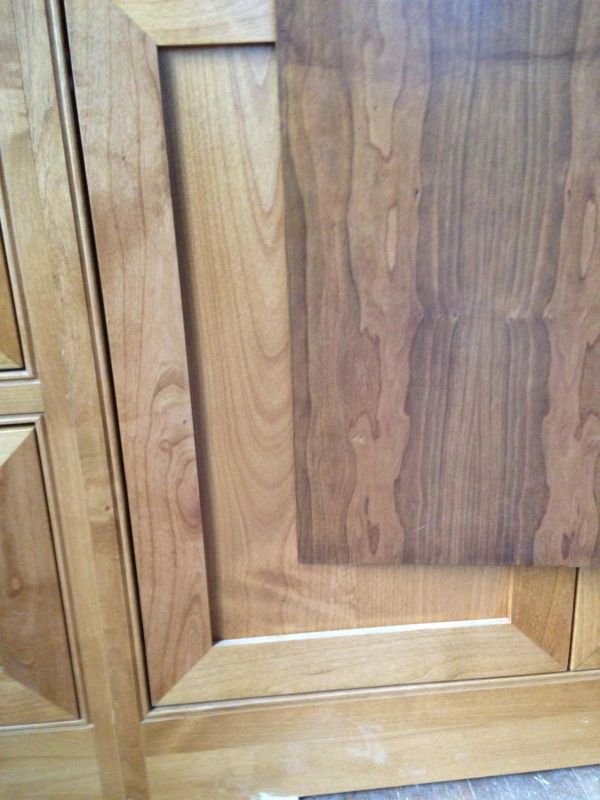Modifying Stain Color on Site
Applying a toner is simple enough, but there are safety issues when you do the work on site. August 27, 2013
Question (WOODWEB Member) :
We recently installed an alder home office with floor to ceiling pre-finished wall paneling. The customer wants the stain to be a shade darker and is willing to pay for the change. When I informed them that the cost to darken it would be 1 1/2 times the original price, she was not so keen on it, and asked if there was a less expensive alternative.
Is there a way to darken the product in-house without taking everything out and re-doing it? We use ML Campbell products and the finish is Honey Oak Stain, one coat Krystal, scratch sand 320, and Topcoat Krystal. Below is the color she wants compared to what we have.

Click here for higher quality, full size image
Forum Responses
(Cabinetmaking Forum)
From Contributor S:
If you can close the area off and have the equipment you could spray a finish compatible toner over what's there . This would also allow you to creep up on the darker color so you don't go too far. You can even get some glazing effects doing this. There will be a loss of transparency in the finish however.
From contributor C:
Four parts thinner, one part Krystal and one part the stain or dye. Then use shading lacquer and bring it around slowly. Take the doors to the booth and tape the room and case interiors off and shoot the frames and panels on site.
From contributor L:
I agree with other posts. Prep, tone in steps and top coat. I prefer dyes to pigmented stains as they don't give the painted look. Since you are using lacquers get her to understand the odor that will persist for a few days. Do it in warm weather so you can vent well.
From contributor M:
Make sure you don't push the limits on the dry film thickness. I know people spray flammable products on-site and get away with it but in my opinion there is an awful lot of risk/liability involved with doing so. Bottom line is that you should make sure your insurance will pay, and not deny coverage if something happens.
From contributor B:
I'm with Contributor M. It's a huge liability. It may be a lot of work to re-install it but charge her for it. If there isn't a lot of trim and millwork I would. Krystal is a great finish but absolutely horrendous and nasty to spray on-site. As you know you have to control the overspray extremely well to get a good finish with it. The fumes will drive the client nuts if they can't leave the house open/vented. I agree with the toner/stain thinned lacquer overcoat. I wouldn't worry about thickness because you only have two light coats, just don't do more than one or two more. I've pushed my luck with Krystal and haven't had the finish crack but have seen it happen. Clients are difficult - you can do full size samples and spray an entire faceframe with mock doors and they will change their mind later.
From the original questioner:
I am going to take some scrap crown from the job and scratch sand it with 320 grit foam pad and apply Briwax and see what that looks like. Do any of you have any experience with that?
From contributor R:
I'd tell them to live with it for a while. Wood will darken over time, plus they will get used to it. The one suggestion of spraying some on-site and some at the shop will certainly give you a two tone job. No way to keep it a consistent color when working in two different places. Even spraying one horizontal, one vertical can make for two different shades. That Briwax may just give you the edge to get them to stop worrying about it.
From contributor C:
Finishing the doors off-site and the cases on-site is very is easy with something called a control sample. Also, the potency of the finish is decreased with a 4-1-1 mixture.
